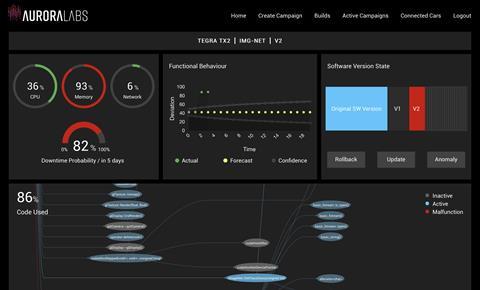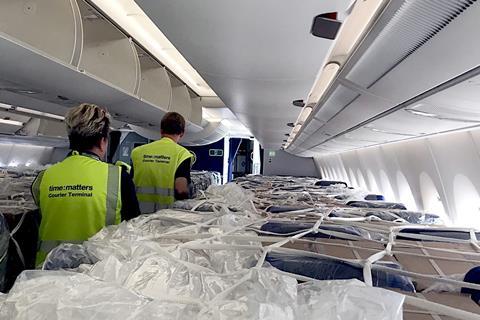As OEMs adopt over-the-air vehicle diagnostics and maintenance, what effect will this developing technology will have on inventory and the surrounding logistics network?

In 2018, over 8m vehicles in the US were recalled solely due to software-based defects. As cars become more and more like ‘computers on wheels’, the frequency of such issues is likely to increase – and this challenge needs to be addressed.
Now, a Tel Aviv-based start-up launched in 2016 has developed technology that allows cars to ‘self-heal’ by remotely detecting – and then fixing – emerging malfunctions before they have an impact. Aurora Labs claims that it can validate and update in-vehicle software without any downtime.
The company is already servicing leading vehicle-makers from its sites in Detroit, US, Munich, Germany and Skopje, North Macedonia, and is now also warmly courting Asian OEMs. The vehicle-makers license Aurora’s line-of-code behaviour software as an enhanced service to car buyers.
”Covid-19 has become a catalyst for change that was already happening. The trend towards online and remote [working], which was happening anyway, has now been given a boost” – Roger Ordman, Aurora Labs
In a sign of how innovative its technology is, in April 2020 the company was tipped by Business Insider as a potential takeover target for Amazon Web Services. Aurora’s executive vice-president of marketing, Roger Ordman, champions its proprietary technology but says it will not shatter existing maintenance and supply chain logistics networks which support the global automotive industry.

“I don’t think Aurora Labs is going to change the whole logistics value chain. But what I do think is happening is that Covid-19 has become a catalyst for change that was already happening. The trend towards online and remote [working], which was happening anyway, has now been given a boost.’
He adds: “When I talk to car manufacturers around the world, they say they are looking at advanced projects and saying ‘how can we simplify this?’. ‘How do we simplify the architecture of the vehicle? How do we simplify the electronics [and] the software?’ I think that [strategy] might be brought closer, earlier.”
Being a new company based in Israel is a benefit, according to Ordman. “We’re coming at it fresh. We’re not competing with Germany, Japan or Detroit to build cars. We don’t have that legacy – but we do have chutzpah, innovation and disruptiveness. We’ll bring that; [the OEMs] will bring their processes, and together we’ll move the industry forward.”
Connectivity becomes crucial
As Aurora highlights, the automotive world is on the cusp of a revolution, with software and connectivity becoming an integral part of conducting business. The management of in-vehicle software has, the company insists, become increasingly important due to its complexity and increasing pressures for ever-shorter development cycles.
General Motors (GM) provides one example. The OEM’s latest electronic platform went into production late last year and should be rolled out to most vehicles in its global line-up by 2023. The technology powers an electronic system capable of managing up to 4.5 terabytes of data processing power per hour – a fivefold increase in capability over GM’s current electrical architecture.
“The critical role of software and its importance to our vehicles, both now and for years to come, cannot be overstated” – Mark Reuss, GM
With an expanded capacity for smartphone-like, over-the-air software updates, the system enables the implementation of functionality upgrades throughout the lifespan of the vehicle. Rapid communications within the vehicle itself and to outside sources are possible thanks to ethernet connections of 100Mbps, 1Gbps and 10Gbps.
“The critical role of software and its importance to our vehicles, both now and for years to come, cannot be overstated,” said GM President Mark Reuss at the launch of the platform in May last year.
Comprehensive software management will therefore be essential for OEMs that want to capitalise on the full business potential of connected cars by enhancing driver experience, enabling post-production revenue, cutting costs through improved efficiency, decreasing risk and reducing recalls.
Proactive vehicle maintenance
The convergence of electrification, 5G, computer vision and software solutions based on artificial intelligence and machine learning will ensure that vehicle-makers can update more than the head unit, infotainment system and telematics control unit. This watershed moment will result in the ability to run software diagnostics and updates for the safety of critical and non-critical components alike throughout the vehicle.
However, that situation lies in the future. As Ordman points out, the paradigm of automotive maintenance today is “I built it, you use it, it gets broken, I’ll fix it”.
He goes on to explain: “The paradigm needs to change to: ‘We’ll build it, we’ll supply it and we’ll constantly be monitoring it with the aim to improve it, so hopefully it never breaks, because we’ll be finding things that are not quite right and fixing them before they go wrong.’”

Carmakers’ capabilities are currently limited to reactive maintenance; when something goes wrong, they try to analyse what happened and then rectify the problem. The in-vehicle error messages are pre-programmed by engineers and are usually software representations of hardware problems such as overheating, tyre pressure and oil pressure.
“These are physical problems represented by an error message that can be remotely accessed and diagnosed. Nobody has yet – until we came along – analysed the software and the behaviour of the functions themselves,” Ordman asserts.
He explains that OEMs are now investing a lot of money in building and securing their cyber security infrastructures, covering in-vehicle technologies, links to the Cloud, networks and gateways.
“The [vehicle maintenance] paradigm needs to change to: ‘We’ll build it, we’ll supply it and we’ll constantly be monitoring it with the aim to improve it, so hopefully it never breaks” – Roger Ordman, Aurora Labs
“Our update files and insights into the maintenance and behaviour of the software use the car manufacturers’ standard file formats, so we seamlessly integrate into their systems and testing, notification security and certification processes,” Ordman says.
The car industry is waking up to the importance of software and the challenge of these complex, dynamic systems. Volkswagen Group, for example, is aiming to write its own software in-house, using a 5,000-strong engineering group with a target of developing 60% of the software for Group vehicles within the next five years.
According to Ordman, the OEM’s biggest challenge will be finding 5,000 people to work on this software – showing how in-demand IT skills will become in the automotive industry of the future.
Regulatory complications
Remote diagnostics and repair have implications for international automotive regulations, too. The UN’s Economic Commission for Europe (UNECD) creates guidelines for type approval regulations which are then put into law, regulated and enforced by national bodies. But how best to regulate software used to update vehicles remotely?
There are myriad issues surrounding type approval and homologation. Considering that there are already about 140 different regulations pertaining to the average vehicle, an added layer for software updates is very likely to exacerbate the regulatory hurdles OEMs need to surmount.

“Six months down the line, if I want to make a software update, if I’m changing the functionality of that vehicle, it’s not the same vehicle that was type-approved,’ warns Ordman.
However, the UN ECD Working Party 29 has just completed its work on regulating software updates and security patches.
Ordman summarises its conclusions: “What they are suggesting is that if you are making a change to the software using over-the-air updates – after it’s been regulated and approved – then if you’re only fixing a problem of a cybersecurity patch and you can prove that’s what you have done, you do not need to request an amended type approval.
“If, however, you’re changing or adding a piece of functionality of the vehicle, it needs to be amended – you need to get different type approval.”
Impact on inventory
At Time Matters, the time-critical logistics provider, CEO Alexander Kohnen is sanguine about the effect that software services such as Aurora’s may have on automotive parts logistics networks.
“Many OEMs are increasingly working on issues such as digitalisation, electrified and autonomous driving – which we can see in the types of goods being shipped. The segment with fast and reliable onsite delivery to technicians is the fastest growing.
‘If a car automatically alerts the garage and sends a message [about] what is needed, the mechanics can have all the parts they need at hand when the car arrives. In this example, the input of the demand is preponed and can be forwarded directly to the manufacturer or the warehouse to arrange JIT [just-in-time] delivery to the garage,” he states.
“We see an increasing demand for high-performance logistics solutions… driven by the fact that warehousing can be further centralised; capital commitment costs will decrease and compensate for the higher freight transport costs” – Alexander Kohnen, Time Matters
Kohnen explains that Time Matters has gained expertise in automated processes from the medical technology segment, where machines order their needs themselves, including parts and technicians.
“We see an increasing demand for high-performance logistics solutions also in this field of the automotive sector,” states Kohnen. “The demand is driven by the fact that warehousing can be further centralised; capital commitment costs will decrease and compensate for the higher freight transport costs.”
Time Matters, an independently operating subsidiary of Lufthansa Cargo, has recently experienced a surge in the number of transport requests, volumes and types of goods which need to be shipped urgently to manufacturing plants around the world because of the Covid-19 crisis, with medical supplies such as masks, gloves, disinfectant gel and other equipment featuring prominently.
Future supply chains
In the long run, Kohnen believes that 3D-printed material will take over warehoused goods for low-cost components that do not require as much production knowledge.

“The majority of parts shipped today in the premium freight sector are more complex and require a high level of expertise in the production process. Three-dimensional printing has not yet taken over these highly complex production processes, but the more investments are made and the fewer parts are needed to produce a car – for example electric cars – the less urgent shipments are required.”
While preparing for the anticipated reduction in physical inventory, in the short term Time Matters is focusing on the high-value parts that cannot be quickly replaced by 3D printing. The company is also applying the lessons learned from medical technology to benefit its automotive customers.
“The bottom line is that digitalisation and an intelligently networked, transparent supply chain will be the decisive success factor of logistics of the future,” says Kohnen.


























![Global[1]](https://d3n5uof8vony13.cloudfront.net/Pictures/web/a/d/s/global1_726550.svgz)













No comments yet